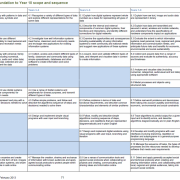Last year, we made the following submission to ACARA on the shape of the Technologies learning area in the new Australian Curriculum currently under development.
Last week ACARA released the draft curriculum for consultation. Survey and open feedback submissions are invited until the 10th of May 2013.

It's very gratifying indeed to see Digital Technologies is now a subject in its own right. Of course the devil is in the details. Now is the time to review this document in detail. Seek out teachers and discuss this with them. Explore the "elaborations" and have a say in the future of Australian technology education.
You must register on the consultation website to access the draft curriculum online and respond to the survey, but you can download a copy of the 108 page draft in PDF format.
Draft Australian Curriculum Technologies - February 2013 (PDF - 621kb)
The Digital Technologies Scope and Sequence (PDF 32kb) on page 71 gives a good overview snapshot - so I've extracted that as a single document for easier access.
Now - back to our submission...
Creative Contingencies response to the shape of the
Australian Curriculum Technologies Learning Area
June 2012
Creative Contingencies is a small IT consulting business and has been working with ICT educators for the past decade. We are deeply involved in the global open source community and interested in the place of open source, open hardware and information technology in the Australian Curriculum.
Our Executive Director, Donna Benjamin sits on the ICT in Education Victoria council, is an advisor to the Ada Initiative, an international non profit working to increase the participation of women in development of open technology and culture, and the international Drupal Association. Our Technical Director, Peter Lieverdink sits on the council of Linux Australia, Australia’s peak body for open source communities.
Background
We acknowledge and commend the position papers released by the Australian Council for Computers in Education (ACCE) and ICT in Education Victoria (ICTEV). They promote the reality of the modern world as one in which computing and digital technology are inherently linked to human thought, action, understanding, communication and
collaboration.
Supporting
VITTA,
ICTEV and
ACCE in recent years has given us a unique outsiders perspective on the role and place of technology in places of education, and within the curriculum. We are not teachers, but we support teachers. We have heard their stories of frustration with their physical networks, watched them mourn the de-emphasising of technology in the curriculum, and seen the flow-on effect of young people’s diminished interest in technology careers.
We would like to thank
ACARA for inviting submissions on the future of Technologies in the Australian Curriculum. This is an extraordinary opportunity to reboot the way we think about this relatively new area of human endeavour - in the context of one of humanities oldest instincts. That is, the development of new technologies to enhance our natural skills and abilities. Enhance and amplify our ability to communicate (internet), to extend our strength, resilience and endurance (robotics), our understanding (big data analysis), our health (bio-informatics). There is no field of human endeavour today untouched by the power of computing and computational thinking. Even mining and agriculture have been transformed. And yet, we are only just beginning to see the transformation in Education itself.

Today’s connected toddlers are already using touch devices. Their interactions with technology today will have a significant impact on the way they learn tomorrow. Discussion is taking place to develop a VCE 5,6 unit with educators of senior secondary students collaborating with tertiary computer science, information systems and software engineering academics.
The information sector is experiencing a crippling skills shortage. It’s true specific skills can be picked up on the job, but tenacious persistence, curiosity and problem solving skills need to be developed over a life time. In his book “outliers”, Malcolm Gladwell popularised the idea that we need to practice for 10,000 hours to achieve subject mastery. This suggests that the 400 hours proposed for digital technologies in the shape paper is grossly inadequate.
The Australian Council for Computers in Education have identified the following key concepts, which underpin their vision for a Computing and Digital Technologies subject.
- The nature of data
- The nature of human computer interface
- The creation and development of knowledge
- The nature of human multimodal communication
- The dimensions and dynamics of ‘The Digital’
We agree CDT is the most important curriculum area of the 21st Century. It provides a gateway to not only all human knowledge, but the very basis of ongoing human evolution. We use the technological advances of humanity as historical markers. Harnessing fire, inventing the wheel, paper, the printing press, the microscope, the telescope, penicillin, television, space flight, the internet. What is now possible, was not before.
But these concepts must be advanced and developed beyond the use of information and communication technology as a General Capability. We must reject the suggestion that to be fluent in the use of technology is sufficient. We must advocate and advance a more direct and engaging participation in the creation and harness of technology and not engender a consumer mentality of learned helplessness.
We very much agree with ICTEV who highlight that “the place of ICT as a general capability must not be devalued nor must it be presented ambiguously... ICT elaborations, indicators, examples of practice, need to be included in all curriculum areas”
Every learning area should ‘reboot’ to see how their subject has been impacted by technology and bring fresh insight into the classroom. Yes, even history has been changed with the digitisation of primary sources from the past, which are now able to be examined through whole corpus computational linguistics.
Open Source Software, Open Hardware and Open Education Resources
Open Source Software and the internet have revolutionised the development of software. Open Hardware is beginning to have just as disruptive an impact on other technology fields. Open Education Resources (OER) have not yet forced significant change, but in some developing markets, OER is providing much needed resources where other options are out of reach. “Open” is no longer emerging. It has emerged.
It’s important the Australian technology curriculum investigates and embraces the global open source community. There are real opportunities for students to learn from living, active projects, and participate on the global stage, doing real work. Not busy work.
Conclusion
Computing and Digital Technologies must be a subject in its own right. It must be developed from the earliest foundation years, and into senior secondary. Pathways to tertiary education - both vocational and research - and to industry must be engineered into the process. But most of all, we must acknowledge that computational thinking extends beyond technology. It is a fundamental activity of humanity
 Today’s connected toddlers are already using touch devices. Their interactions with technology today will have a significant impact on the way they learn tomorrow. Discussion is taking place to develop a VCE 5,6 unit with educators of senior secondary students collaborating with tertiary computer science, information systems and software engineering academics.
Today’s connected toddlers are already using touch devices. Their interactions with technology today will have a significant impact on the way they learn tomorrow. Discussion is taking place to develop a VCE 5,6 unit with educators of senior secondary students collaborating with tertiary computer science, information systems and software engineering academics.

